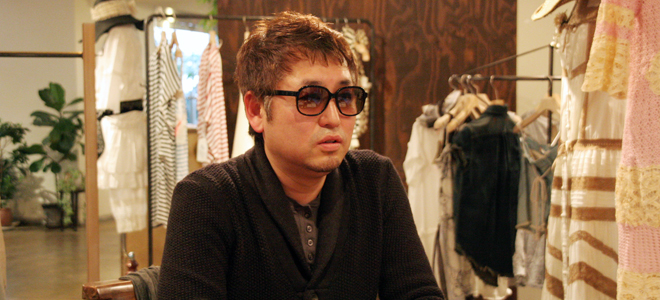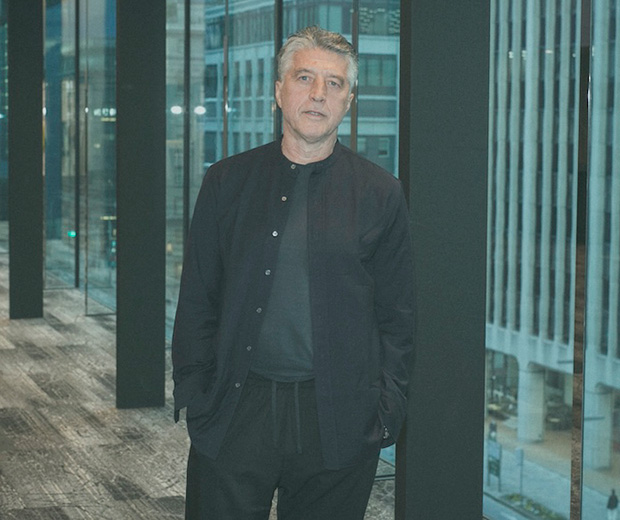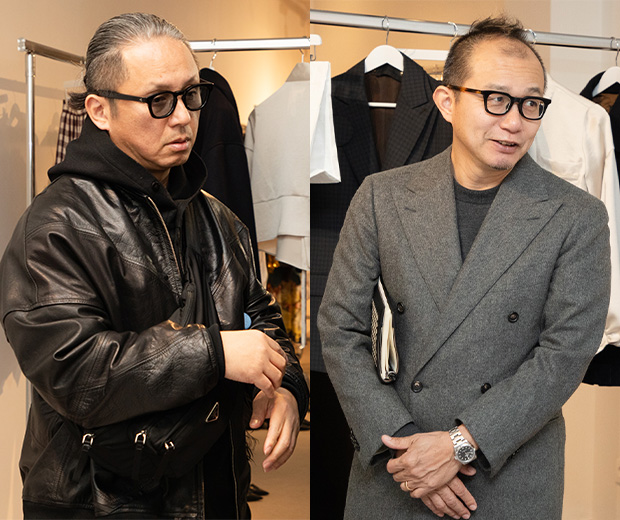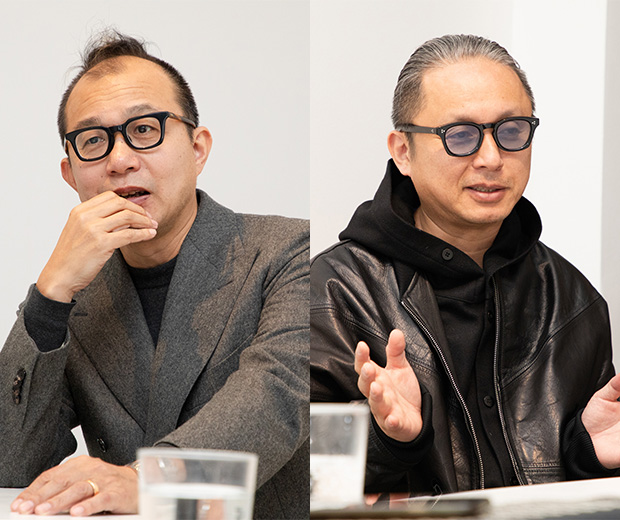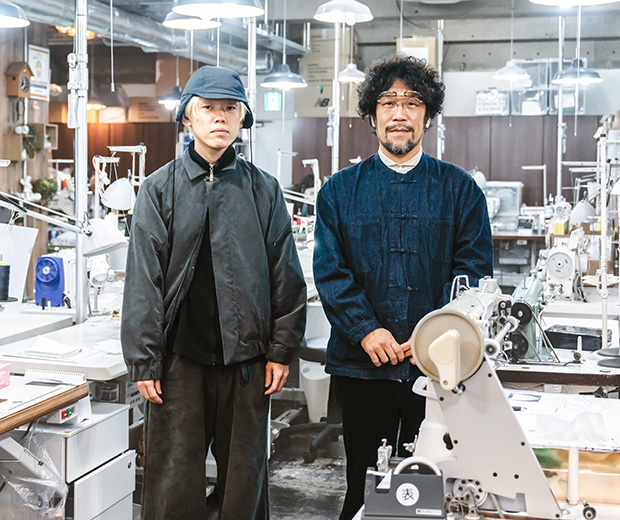KOICHI CHIDA
During his approximate 20 year career, Koichi Chida has been involved with various brands and shops, and is presently the creative director of fur fur, which has succeeded at winning the hearts of girls with a heightened sense of fashion. The balance between business and creation is important to keep a fashion brand going and Koichi Chida has been able to do this with insight and observation in a way that fits the times.
We spoke with him about the birth of fur fur and how he is able to create shows that introduce us to a unique world. We also asked him about the state of fashion brands, his perception as a director and what he deems to be particularly important in regards to shows.
The appearance of Snoopy at the 2011 Spring/Summer Show in October of last year was all the rage. And, the three-way collaboration with the PEANUTS and Brazilian artist Yomar Augusto was of particular interest, how did you achieve such a feat?
Chida: Collaborative efforts take shape in two ways, they can be planned, or sometimes they just happen in the flow of things. It’s similar to the various ways there are to making clothes. I used to have a perfect picture of completion in my mind that I worked towards, but now, I tend to go along as I work and eventually reach a point of completion. I create whilst being influenced by the people, things and events that surround me. I have always loved Snoopy and worked on a collaborative effort with another brand and the PEANUTS, the comic in which Snoopy appears, about 5 or 6 years ago. So, I’ve wanted to do something with Snoopy and fur fur for some time now. There was a book that was a huge hit in the 60’s written by Charles M. Shultz entitled, “Happiness is a Warm Puppy”; every household owned a copy. It was translated into Japanese by Shuntaro Tanikawa. The story of the “PEANUTS” can be bitter-sweet. And, this book is an illustrated, condensed version of this underlying message. The Brazilian artist Yomar is good at calligraphy, so inspired by “Happiness is a Warm Puppy” he starting thinking about the design possibilities with calligraphy. The result was a visual with an illustration of Snoopy in the center of Yomar’s calligraphy (cape look).
The same goes for this collection, there was no encompassing theme, things just overlapped and developed as we went along to eventually culminate in the finished product. So, when the show begins I sometimes think to myself, “ah, so this is what became of it”.
When you say, “go with the flow”, do you mean to say that sometimes you leave creation up to your staff?
Chida: Sometimes. After my assistant quit some time ago, I made her assistant, Aya Furuhashi, a designer for FUR (the predecessor to fur fur). We took the first three letters of her name, “FURUHASHI” to name the brand “FUR”. She had only been with us for one or two years at the time and she had never won any contests or anything while attending professional school. She didn’t really stand out to be frank. But, when you see how she writes, or listen to how she speaks, you feel this vibe. This is where my insight played a part, maybe. I fell in love with the touch of the illustrations she draws. I’m not interested in illustrations that anyone will see and say, “that’s good!” The illustrations that Furuhashi draws made me think, “this girl has something”. Her way of thinking and prioritizing is similar to mine which is why we’ve been able to work together for so long; Furuhashi made me see the future.
When we started FUR in 2006, my company had been in business for six years and it was getting to be time for me to step away from directing and get more involved in running the company. So, I wanted Furuhashi to take the reigns on the FUR line. We changed the brand name from FUR to fur fur, and I had Furuhashi freely create this debut collection that bears her name. Once she had a foundation, I would work on it a little and add things as we moved forward, and even mess things up on purpose. She tends to start creating before thinking of a concept. The accumulation of different aspects eventually produces something, but this is not a good basis for a brand. I’m more conceptual, so we’ve gone five seasons with her creating and me coming up with the concepts. For our sixth season (2010-11 Autumn/Winter) we tried to compile wedding images with the help of a bridal salon that we had worked with on fur fur in the past, all based on the model of an old church that I had found in Europe. But, we used a lot of layers of clothing which, unfortunately, got labeled as “girls of the forest” (mori girl) style, and we started to gain attention as the roots for this look, which led to a lot of TV and magazine interview requests. It was a lot of trouble. It seems that there was some link between the world of Furuhashi’s creations and the way she layered clothing, with the “girls of the forest” look. A journalist friend of mine said to me, “the perfection level of the show is amazing”, which honestly made me feel a little conflicted about the whole thing.
Regardless of whether the forest girl look is good or bad, it may just be that the collection at the time perfectly matched the sense of the times, right?
Chida: I think the 2010-11 Autumn/Winter show was completed with the utmost attention to subtle timing, from everything from the clothes to the presentation. For the music we had a female violinist perform live; she was new on the scene and Columbia Records was really pushing her as part of their 100th anniversary. Actually, I had spotted her in our press room and approached her because I thought she “had charisma”. She told me that she was an aspiring violinist so I asked her to play for the show. So, the show was just an accumulation of perfect coincidences; we had this model of an old church, a partnership with a bridal salon, and then the coincidental meeting with a violinist.





2010-11 AW COLLECTION
The fur fur’s shows are unique; it’s interesting to hear that they’re created in that manner.
I get the sense that you pay particular attention to certain details of the show.
Chida: It may be misleading, but the NY show is like watching a walking look book, right? It’s like what they sell matches what they want to make; the journalists don’t even have to go to the exhibition, going to the show is enough. But, no one expects a show like that in Japan. They want something emotional and entertaining. But, then again, not like a Paris show; there needs to be an expression of Tokyo in there. It’s a dilemma for creators, but the people that attend the Tokyo show don’t look at the clothes. Of course, some look carefully at the exhibition, but the journalists don’t come to the exhibition. You can’t say that a brand having a show is doing well from a business aspect; but then again in Japan you can’t really say that the show is being leveraged for business either, it’s a tricky thing.
For the last show (2011 Spring/Summer) I employed a system where I went all out to create a show that would make a lasting impression and planned to have everyone look closely at the clothes at the exhibition. I had help from stylist Yoko Omori, who I’ve known since I was in my twenties. It was the first time we worked together, and I had heard rumors about how tough she is. I showed materials and ideas that I had gathered about the show to her and she scoffed at me saying, “you think too much like a man” (laugh). She said to me, “I can make you think like a woman” and proceeded to take my ideas and transform them into a finely structured, concise creation. About two weeks prior to the show, we gathered all staff members at the atelier and Yoko explained the collection concept all the time getting furious at staff members who couldn’t keep up. She was very passionate about her work. But, she told me that it was the most enjoyable work she had had in the last five years, which was a pleasure to hear.
This show gave me the opportunity to rethink things. At the show I don’t think about the MD or anything, I just tear down the walls. But, that’s because there’s an MD at the exhibition, and I can show the clothes there.







2011 SS COLLECTION
I think that the way you feel about shows, in respect to them being emotional and impressionable, is in a way what shows were always meant to be like.
Chida: But, the business side is also important. It’s crucial to have various ideas come into your head when you think about to make the show a place for doing business. When I look back myself 20 years ago, as a young aspiring designer, I remember that I had lots of ideas in my head and thought about how interesting it would be to combine them. That’s all I’m doing now. The only difference is that even if you clash ideas together, you will not succeed if there is no link to the day and age; I think you can lose sight of that if you’re only involved in design.
Not to change the subject, but you taught at the Bunka Fashion College for the first time the other day, right?
Chida: I have lectured and given talks there many times, but this was the first time I taught. I gave a 90 minute lecture to a class of 51 seniors, but I totally bombed. What made it even harder was the fact that Yumiko Haba, the editor of Soen, was sitting in the back of the room (laugh). When I got on Twitter and said it “went terribly” I got scolded by work friends and a friend from high school who teaches at a cram school (laugh). I’ve got to give it another shot sometime. I still don’t consider myself someone who should be talking in front of others, and had declined previous offers to teach. The only reason I accepted this time was because I had been asked by a former teacher of mine who was about to retire. But, the experience has motivated me to become a better teacher.
What do you think about students these days?
Chida: You know, the economy is bad, but I think students are finally starting to act like students. For example, in the US, students don’t have any money, and the only ones who can go to clubs to party are adults. In my younger days, students still had little money, but we were at least able to use it, so we partied. Even now in Japan, young people buy clothes, but those years are almost over, I think. 20 years ago, people were often asking, “in Japan, why do young people buy so many clothes while adults do not?” In other words, Japanese fashion was called “childish”, but we’ve finally entered an age where children cannot buy clothes. I think this is a good thing. It means that young people are realizing that if they get into society and work hard, they will eventually be able to buy clothes and have fun, which is how it is in other places in the world. It used to be said that in Japan, even if you had a show, the only clothes that would sell were childish, but I think we’ve finally entered an age where adult clothing is selling.

